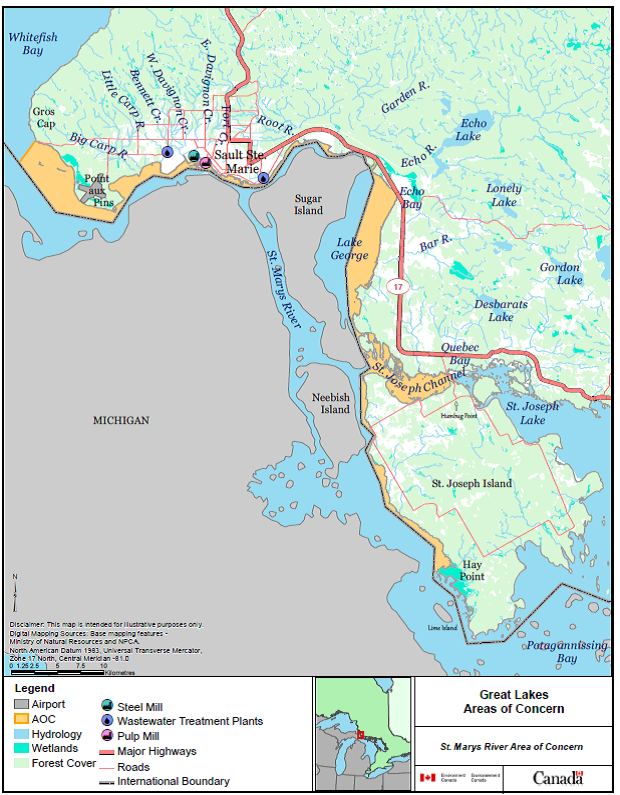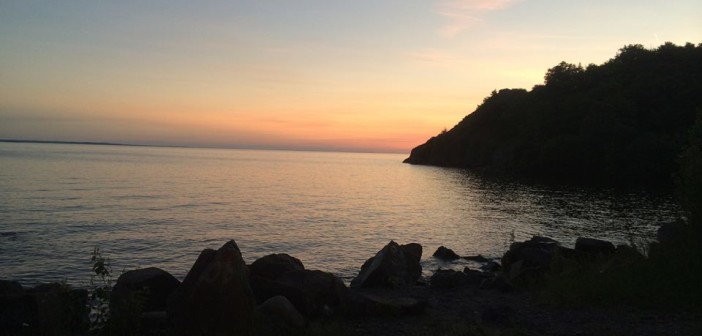The St. Marys River Remedial Action Plan (RAP) was established in 1987 following an amendment of the Canada – United States Great Lakes Water Quality Agreement. The agreement identified Areas of Concern (AOC) including the site along the St. Marys River.
AOC’s are defined as hot spots where the environment has been harmed to the point that it affects the enjoyment, use and health of that area. There were originally forty-three AOC’s designated throughout the Great Lakes in both Canada and the United States. The St. Marys River is one of only five AOC’s that is a bi-national effort. Both governments have been working together towards river restoration goals.
 Corrina Barrett is the RAP Coordinator. For the past five years her position has been funded through Environment Canada and the Ministry of Environment and Climate Change. However, the program is running out of money and for the first time in five years Corrina’s position may be at risk. With her contract ending March 31st 2015, the program has applied for funding to extend her position for one more year. In her role Corrina focuses on education and outreach as well as operating as the coordinated voice for the Bi-National Public Advisory Council (BPAC). BPAC represents the public voice of citizens on both sides of the river.
Corrina Barrett is the RAP Coordinator. For the past five years her position has been funded through Environment Canada and the Ministry of Environment and Climate Change. However, the program is running out of money and for the first time in five years Corrina’s position may be at risk. With her contract ending March 31st 2015, the program has applied for funding to extend her position for one more year. In her role Corrina focuses on education and outreach as well as operating as the coordinated voice for the Bi-National Public Advisory Council (BPAC). BPAC represents the public voice of citizens on both sides of the river.
“I wouldn’t feel right about leaving the program before knowing that the St. Marys River is at the point where everyone can use it properly and enjoy it,” she remarked at her event, St. Marys Night, hosted at the Algoma University Speakeasy on Wednesday evening.
There were about sixty individuals present at the event which highlighted an update of the RAP progress followed by a viewing of the documentary, Waterlife. As overheard at the event there were “more people present for the viewing than one might find at any movie theater in the Sault”.
 Of the fourteen environmental challenges that can affect an AOC, only five have been found to not be of concern in the St. Marys.
Of the fourteen environmental challenges that can affect an AOC, only five have been found to not be of concern in the St. Marys.
But don’t be sad! There’s good news too!
Reports are showing that in three hot spots: east of Top Sail Island, an area near Bellevue Marine Park and an area around Lake George Channel are showing a trend towards less contaminant settlements. These areas experience higher than suggested government levels of contaminants, though these sediments are found 10 cm beneath the first layer of sediment, and do not present a tremendous risk to the environment and human health.
“However,” explained Corrina. “With issues like water levels going down in the Great Lakes and possible increases in freighter traffic which could result from projects like the Port coming to the Sault, that’s when these areas could become of greater concern, as problem sediments could be re-exposed.”
Studies of the sediment in St. Marys River shows that one centimeter of compressed and clean sediment are overlaying historical contaminant elements each year. As well the benthic community (tiny organisms on the bottom of the river) and the fish community are returning to a level expected of the St. Marys River.
Another positive observation was the lack of impact on water quality by the agricultural sector.
“We have a very small amount of agriculture in a very large area. As well most of the agriculture that happens, especially in Algoma is quite sustainable,” commented Corrina. “The Rural Agri-Innovation Network addresses best farming practices and the farmers in the area are a lot more conscious about their impact on the environment.”
Among ongoing concerns are the reality of beach closures and storm water.
Reporting high levels of E. coli throughout the summer seasons, beaches along the St. Marys River have been subjected to regular closures. It has been a particular challenge on the Michigan side of the river where many connecting tributaries pass through areas with high concentrations of farming and bird populations.
“Bird populations do tend to culminate in areas like beaches. It’s a perfect habitat for them,” remarked Corrina. “When we restore a beach we’re actually not only making the area more attractive to people but to geese as well. We go to the beach because it’s sandy and warm- and that’s why the geese like to go there too.”
A few years ago, Sugar Island reported concerns over an alarming amount of Canadian feminine hygiene products, prophylactics and McDonald’s coffee cups on the shoreline. How do we know it was Canadian trash? Why the bilingual packaging of course!
The pressing concern was that the debris may have been sourced from the Sault Ste. Marie Wastewater Treatment Plant but an investigation into the mater proved otherwise. Storm sewers on both sides of the river were driving every cigarette butt and lollipop stick into the St. Marys River.
“The waste water that comes out of our treatment plant is of almost the exact same quality of the river itself,” explained Corrina. “Storm water is not the same. Storm water is not treated. Storm water is literally the water that washes off the street and it is a universal problem. Whatever you’re doing outside ends up in that river.”
 Both sides of the river have worked towards mitigating the issue of nasty storm water and Sugar Island has enjoyed a relatively clean shoreline for the past two years. At present the City of Sault Ste. Marie is looking into storm water programs to further ensure the water quality of the river.
Both sides of the river have worked towards mitigating the issue of nasty storm water and Sugar Island has enjoyed a relatively clean shoreline for the past two years. At present the City of Sault Ste. Marie is looking into storm water programs to further ensure the water quality of the river.
In addition to efforts around the AOC, Algoma University received funding to conduct an overall water quality project of the St. Marys River. The goal is to identify the ambient condition of the river and five locations for testing have been identified: Gros Cap, Top Sail Island, Bell’s Point, Echo Bay and St. Joe’s Island.
The project will also take an ‘unscientific’ look at the aesthetics of the river. Corrina explained that fifty years ago, people complained of offensive odours coming from the river, the presence of oil sheens on the water surface, algae mats and in general- gross looking water. Remnants such as pulp, paper and wood littered the shoreline and the contamination pouring out from industry and municipal wastewater obviously visible and unmistakable.
But a half century worth of dedication and advocacy for water quality in the St. Marys River has paid off.
“We’re very fortunate. We have a world class fishery here and the water quality is returning to acceptable parameters set out by the government. And the river is quite pretty now. The City has developed a boardwalk to make it an area that we are proud of. The St. Marys River is of better quality than some of the other areas around it. And that’s because it’s had such of rally of support and so much attention.”
The next step for the St. Marys River will be to determine that the actions taken to address the environmental issues affecting the river have effectively remedied the problem.


